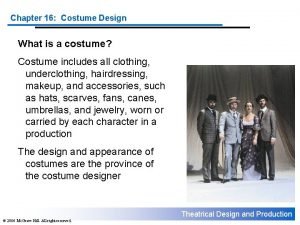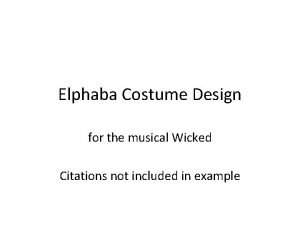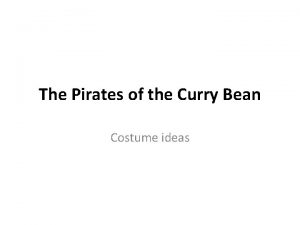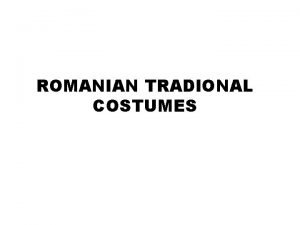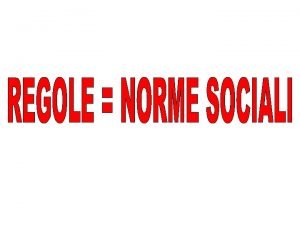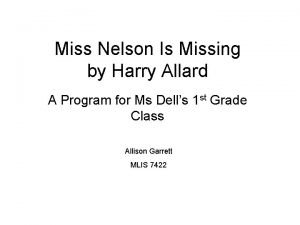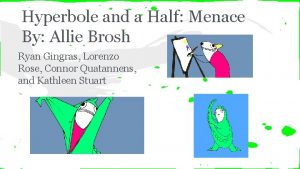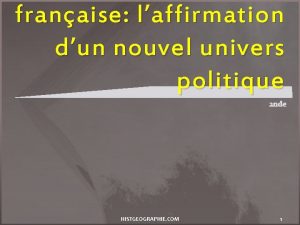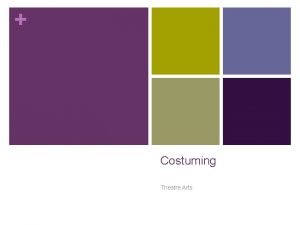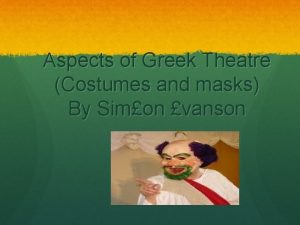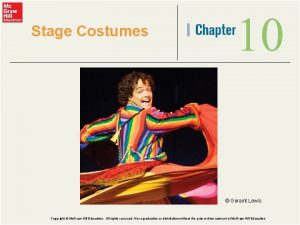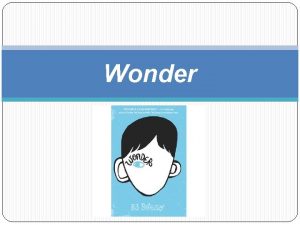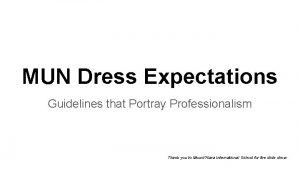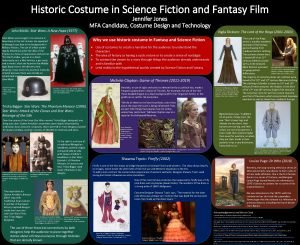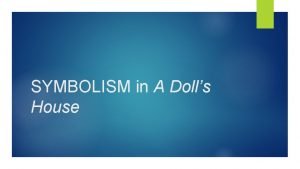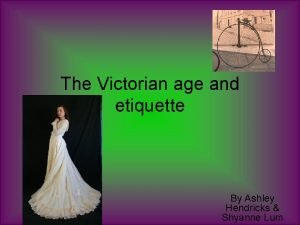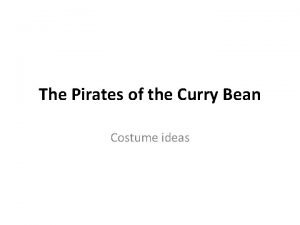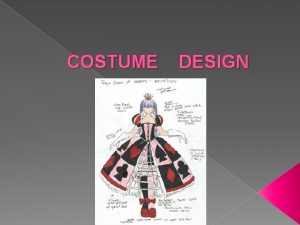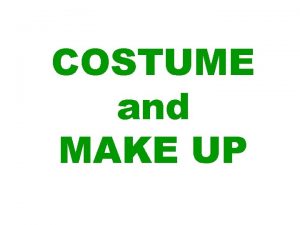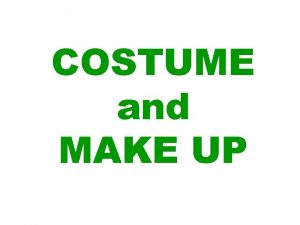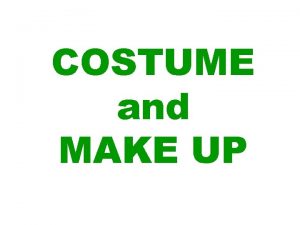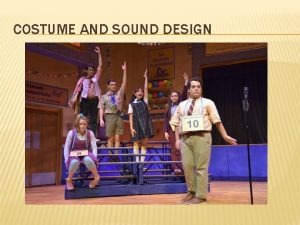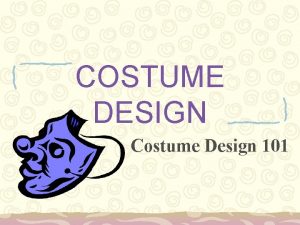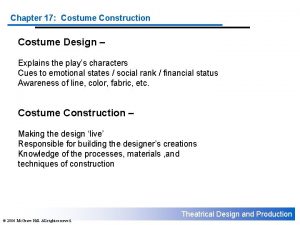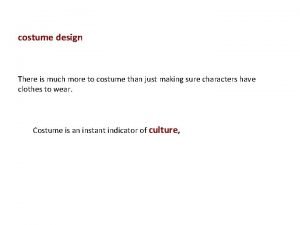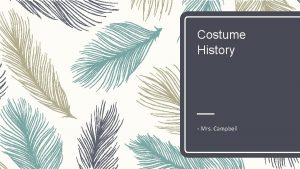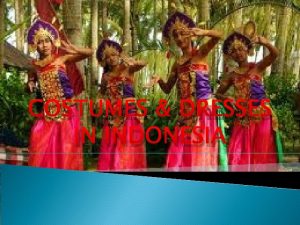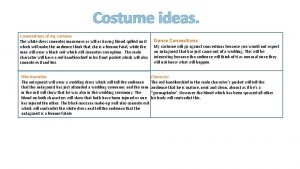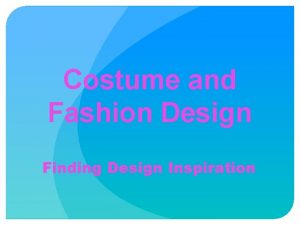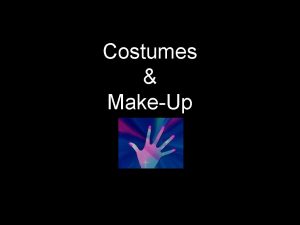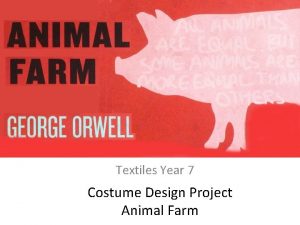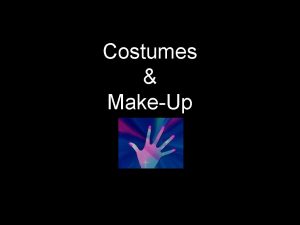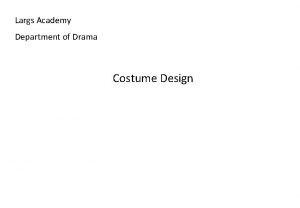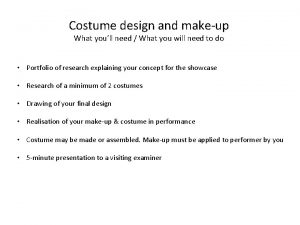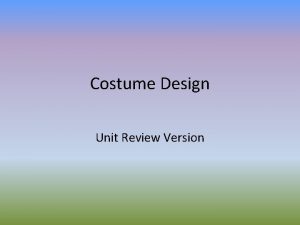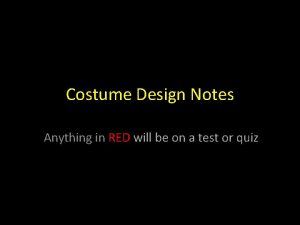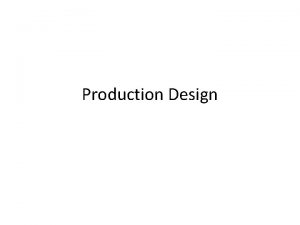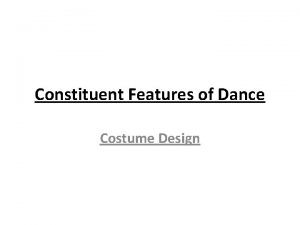Chapter 16 Costume Design What is a costume





































- Slides: 37

Chapter 16: Costume Design What is a costume? Costume includes all clothing, underclothing, hairdressing, makeup, and accessories, such as hats, scarves, fans, canes, umbrellas, and jewelry, worn or carried by each character in a production The design and appearance of costumes are the province of the costume designer Theatrical Design and Production © 2006 Mc. Graw-Hill. All right reserved.

Chapter 16: Costume Design The Nature of Costume Design To be effective, costume designs for a production need to do the following: Reflect the production design team’s agreed-upon interpretation of the production concept Exhibit a unity of style among all costume designs for a production Provide a visual reflection of the personality and nature of each character Provide visual information about the world of the play: locale, period, season, time of day, culture, and the socioeconomic, religious, and political environment Theatrical Design and Production © 2006 Mc. Graw-Hill. All right reserved.

Chapter 16: Costume Design Types of Costume Designs Character Costume Designs that are dictated by specific information contained in the script Decorative Costume Designs Those costumes that appear to be no more than decorative elements in the general stage picture— extras, showgirls, etc. Every costume in a production could be placed somewhere on this character/ decorative continuum Theatrical Design and Production © 2006 Mc. Graw-Hill. All right reserved.

Chapter 16: Costume Design The Psychological Meaning of Clothes What a person wears, and how it is worn, says a great deal about that person and the society in which he or she lives A certain type of clothing can be worn to conform to or rebel against a certain segment of society Clothes can also be visible clues to the wearer’s emotional state Theatrical Design and Production © 2006 Mc. Graw-Hill. All right reserved.

Chapter 16: Costume Design Objective Information Provided by Clothes In addition to providing psychological clues, clothing can provide a variety of objective information about a person Historical Period Age Gender Socioeconomic Status Occupation Climate and Season Theatrical Design and Production © 2006 Mc. Graw-Hill. All right reserved.

Chapter 16: Costume Design Objective Information Provided by Clothes Historical Period The shape and silhouette of garments can provide clear indications of their historical period Theatrical Design and Production © 2006 Mc. Graw-Hill. All right reserved.

Chapter 16: Costume Design Objective Information Provided by Clothes Age In any period, the color, style, and fit of clothes provide information about the age of the wearer Young people tend to reveal more of their bodies than do their elders Theatrical Design and Production © 2006 Mc. Graw-Hill. All right reserved.

Chapter 16: Costume Design Objective Information Provided by Clothes Gender Throughout history, with a few exceptions, clothes have almost always clearly indicated the gender of the wearer Theatrical Design and Production © 2006 Mc. Graw-Hill. All right reserved.

Chapter 16: Costume Design Objective Information Provided by Clothes Socioeconomic Status Social status has always been indicated with clothes Ill-kempt clothes of homespun Beautifully fashioned linens, silks, and satins Theatrical Design and Production © 2006 Mc. Graw-Hill. All right reserved.

Chapter 16: Costume Design Objective Information Provided by Clothes Occupation Similar to the clues that clothing provides about a character’s socioeconomic status, clothes can also tell us about a person’s job Uniforms are an obvious indicator Theatrical Design and Production © 2006 Mc. Graw-Hill. All right reserved.

Chapter 16: Costume Design Objective Information Provided by Clothes Climate and Season If we see someone bundled up in a heavy fur coat, we assume that the weather is cold Dark hues, heavy fabrics, and multiple layers are indicators of cold climates Light colors, lightweight fabrics, and fewer clothes are indicators of warmer weather Theatrical Design and Production © 2006 Mc. Graw-Hill. All right reserved.

Chapter 16: Costume Design General Considerations for Costume Design A variety of diverse considerations and sources of information affect the work of the costume designer Analyzing the script Other Conceptual Considerations Practical Considerations Theatrical Design and Production © 2006 Mc. Graw-Hill. All right reserved.

Chapter 16: Costume Design General Considerations for Costume Design Analyzing the script The costume designer reads the script to gather various information about the play and the characters The script provides factual information about period, time, season, climate, gender, age, socioeconomic status, occupation, etc. Script also provides clues to the emotional quality of the play and the relationships among the characters Theatrical Design and Production © 2006 Mc. Graw-Hill. All right reserved.

Chapter 16: Costume Design General Considerations for Costume Design Other Conceptual Considerations Stereotypical costuming Character evolution Costume stylization Interpretation of period Interpretation of color and fabric Theatrical Design and Production © 2006 Mc. Graw-Hill. All right reserved.

Chapter 16: Costume Design General Considerations for Costume Design Stereotypical costuming The actor, not the costume, is the primary vehicle for conveying a character’s nature and personality Costume designers normally avoid stereotypical designs that proclaim who the character is The obvious exception are production concepts that are two-dimensional and cartoonish—Guys and Dolls Theatrical Design and Production © 2006 Mc. Graw-Hill. All right reserved.

Chapter 16: Costume Design General Considerations for Costume Design Character Evolution Costumes need to match the growth and change that characters experience during the course of the production Theatrical Design and Production © 2006 Mc. Graw-Hill. All right reserved.

Chapter 16: Costume Design General Considerations for Costume Design Costume Stylization The degree of stylization dictated by the script and production concept must be recognized by the costume designers Theatrical Design and Production © 2006 Mc. Graw-Hill. All right reserved.

Chapter 16: Costume Design General Considerations for Costume Design Interpretation of Period Costumes make a statement that visually unifies the historical period, the style of the script, and the production concept However, any historical period has a plethora of design styles with subtle variations Costume designers need to distill that mound of information into details that represent the essence of the period Theatrical Design and Production © 2006 Mc. Graw-Hill. All right reserved.

Chapter 16: Costume Design General Considerations for Costume Design Interpretation of Color and Fabric Historical research will acquaint the costume designer with the color and types of fabrics used in a particular historical period The colors and fabrics selected must be appropriate to the production concept and the individual characterizations Theatrical Design and Production © 2006 Mc. Graw-Hill. All right reserved.

Chapter 16: Costume Design General Considerations for Costume Design Practical Considerations Needs of the Actor Production Venue Budget Construction Demands of the Design Renting Costumes Buying Costumes Modifying Stock Costumes Theatrical Design and Production © 2006 Mc. Graw-Hill. All right reserved.

Chapter 16: Costume Design General Considerations for Costume Design Needs of the Actor The actor’s needs can be divided into two categories: physical and psychological The physical needs: the costume should fit, be reasonably comfortable, and shouldn’t inhibit any necessary and appropriate motion The simple act of putting on a costume psychologically helps the actor become the character The hobble skirt requires that women wearing them take tiny steps Theatrical Design and Production © 2006 Mc. Graw-Hill. All right reserved.

Chapter 16: Costume Design General Considerations for Costume Design Production Venue Costume design is also influenced by the production venue The small, delicately tinted pastel embroidered flowers on a blouse would be completely lost in a large proscenium theatre Theatrical Design and Production © 2006 Mc. Graw-Hill. All right reserved.

Chapter 16: Costume Design General Considerations for Costume Design Budget The amount of money in the costume budget, and the time and staff available, have a direct effect on design choices Theatrical Design and Production © 2006 Mc. Graw-Hill. All right reserved.

Chapter 16: Costume Design General Considerations for Costume Design Construction Demands of the Design Construction demands are predicated on the number of costumes in the production, the complexity of the individual designs, the budget, and the expertise of available personnel While costumes may be built, they can also be rented, bought, or “pulled” from stock Pull—remove a costume from storage for use in a production Theatrical Design and Production © 2006 Mc. Graw-Hill. All right reserved.

Chapter 16: Costume Design General Considerations for Costume Design Renting Costumes Carefully tailored, period-specific items such as military uniforms and expensive men’s suits are frequently rented Theatrical Design and Production © 2006 Mc. Graw-Hill. All right reserved.

Chapter 16: Costume Design General Considerations for Costume Design Buying Costumes When producing a contemporary production, costume designers frequently buy clothes “off the rack” and modify them Theatrical Design and Production © 2006 Mc. Graw-Hill. All right reserved.

Chapter 16: Costume Design General Considerations for Costume Design Modifying Stock Costumes Educational and regional professional companies frequently have a stock of costumes that have been used in previous productions Theatrical Design and Production © 2006 Mc. Graw-Hill. All right reserved.

Chapter 16: Costume Design Organizational Paperwork The costume designer must keep track of amazing amounts of detail regarding every costume in the production It is essential that he or she make copious and complete notes Most costume shops have a “costume bible” This book holds all the information regarding the planning and construction of a particular show Theatrical Design and Production © 2006 Mc. Graw-Hill. All right reserved.

Chapter 16: Costume Design Organizational Paperwork While the specific information contained in a “costume bible” obviously varies from company to company However, it normally will include the following Cast list and production contact sheets Measurement sheets Calendars and deadlines Costume plots and lists Budget sheets Rental contracts and pull lists Copies of renderings Swatches and dyeing instructions Production notes from the stage manager Theatrical Design and Production © 2006 Mc. Graw-Hill. All right reserved.

Chapter 16: Costume Design Organizational Paperwork Costume Chart The costume chart is used to visually plot what each character wears in each scene in the play Some costume designers attach color samples to each listing so that they can see the development of the overall color scheme of the production Wardrobe personnel use the costume chart as a guide when dressing the actors Theatrical Design and Production © 2006 Mc. Graw-Hill. All right reserved.

Chapter 16: Costume Design Organizational Paperwork Costume List The costume list specifies every element, including accessories, of each costume worn by every actor Broken into two section, men and women (in larger productions it can be further divided into principal men, principal women, etc) Quick changes are noted The list is used by dressers and wardrobe crew as a checklist for the costumes in a production Theatrical Design and Production © 2006 Mc. Graw-Hill. All right reserved.

Chapter 16: Costume Design Organizational Paperwork Character-Actor Dressing List This list is used by the actors and dressers during dress rehearsals and performances Posted in the actors’ dressing rooms or any place where actors change costumes It details everything, including accessories, that the actor wears in each scene Theatrical Design and Production © 2006 Mc. Graw-Hill. All right reserved.

Chapter 16: Costume Design Organizational Paperwork Costume Calendar The costume calendar helps the costume designer budget time and provides a visualization of how much time is to be devoted to each phase of the process To be effective, it must include all facets of the process Theatrical Design and Production © 2006 Mc. Graw-Hill. All right reserved.

Chapter 16: Costume Design Visual Presentation of the Costume Design Costume designers create several types of drawings Preliminary sketches Costume layout Final costume sketch or rendering Theatrical Design and Production © 2006 Mc. Graw-Hill. All right reserved.

Chapter 16: Costume Design Visual Presentation of the Costume Design Preliminary sketches The time when the first visible results of the creative process appear on paper These sketches drawn in pen or pencil, are the first tangible results of the synthesis of the costume designer’s thoughts, ideas, and research They are rough sketches—like thumbnail sketches of the scene designer Theatrical Design and Production © 2006 Mc. Graw-Hill. All right reserved.

Chapter 16: Costume Design Visual Presentation of the Costume Design Costume Layout The costume layout is a group of small figures that illustrate the costume designs for a number of characters Sketched in pencil or ink, the costumes may be fully or partially colored The purpose is to provide an overall view of the costume concept for the entire production Costume layouts are used to provide the director and costume designer with an overview of how the costumes will look and work together Theatrical Design and Production © 2006 Mc. Graw-Hill. All right reserved.

Chapter 16: Costume Design Visual Presentation of the Costume Design Costume Sketch Created by the costume designer, the costume sketch or plate is a full-color drawing that should give a strong indication of character, and the costume should look like Drawn with a single character plate, the sketch should provide clear and accurate information about the line and detail of the garment They often contain swatches of fabric, notes, and the name of the character and scene in which the costume is worn If available, photocopies of these research materials are frequently provided Theatrical Design and Production © 2006 Mc. Graw-Hill. All right reserved.
 Zazu puppet
Zazu puppet Practical considerations for costume design might include
Practical considerations for costume design might include Costume design wicked
Costume design wicked Traditional hungarian clothing
Traditional hungarian clothing Pirates of the curry bean props
Pirates of the curry bean props How has peeta managed to stay safe
How has peeta managed to stay safe Vocabulary hat parade ideas
Vocabulary hat parade ideas Red flexer timisoara
Red flexer timisoara How to make a johnny appleseed hat
How to make a johnny appleseed hat Esempi di norme sociali
Esempi di norme sociali Miss nelson costume
Miss nelson costume Tenue traditionnelle bourguignonne
Tenue traditionnelle bourguignonne La dépouille du minotaure en costume d'arlequin
La dépouille du minotaure en costume d'arlequin Signing naturally 7.13 answers
Signing naturally 7.13 answers Hyperbole and a half dinosaur
Hyperbole and a half dinosaur Frise républiques françaises
Frise républiques françaises Costume vocabulary list
Costume vocabulary list Costumes in greek theatre
Costumes in greek theatre Looks dalam scratch adalah
Looks dalam scratch adalah Turkish traditional clothing
Turkish traditional clothing Meriwether lewis costume
Meriwether lewis costume Spanish traditional costume
Spanish traditional costume Norme di costume
Norme di costume How can you add a new costume of sprite
How can you add a new costume of sprite Costume plot example
Costume plot example North america costume
North america costume Julian from wonder
Julian from wonder Costume
Costume Traditional slovenian clothing
Traditional slovenian clothing Mun costume
Mun costume Costume science fiction
Costume science fiction Jeopardy halloween movies
Jeopardy halloween movies A doll's house symbols
A doll's house symbols Elizabethan theatre parts
Elizabethan theatre parts Dayak traditional costume
Dayak traditional costume Props of tinikling
Props of tinikling In 1896 arbiters of fashion a specific costume for cycling
In 1896 arbiters of fashion a specific costume for cycling Pirates of the curry bean costumes
Pirates of the curry bean costumes

